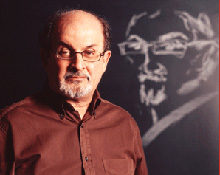Events
January 11, 2010
Rushdie archive opening to be 'landmark' for all

Salman Rushdie
The archive of celebrated author and Emory University Distinguished Writer in Residence Salman Rushdie will open to the public for the first time on Friday, Feb. 26 in Emory’s Woodruff Library. A multimedia exhibition, “A World Mapped by Stories: The Salman Rushdie Archive,” will be on display in the Library’s Schatten Gallery from Feb. 26-Sept. 26.
As part of the opening celebration, Emory will host a symposium with Rushdie, author Christopher Hitchens and filmmaker Deepa Mehta titled, “The Only Subject is Love: Imagining Better Worlds,” on Friday, Feb. 26 at 1-3:30 p.m. in the Schwartz Center. Rushdie, Hitchens and Mehta will discuss how the imagination helps to address the global challenges of our times.
“The opening of the archive is a landmark event for scholars and the public,” says Rick Luce, vice provost and director of Emory University Libraries. “The Rushdie archive signifies two major trends of our time: the globalization of arts and letters, and the digital world in which contemporary writers and artists, such as Mr. Rushdie, are now composing their masterpieces.”
“Rushdie is a major figure of world literature,” notes Bobby Paul, dean of Emory College. “The scope of Rushdie’s work, and his readership, are global to an extent that compels us to expand our notion of writers as speaking for a specific geography or people. Rushdie’s writing weaves together mythology, pop culture, politics and religions from Asia to the Americas to epic effect.”
Archive, exhibition reveal Rushdie's vision
The archive, including Rushdie’s manuscripts, drawings, journals, letters, photographs and digital materials, along with the exhibition, reflects the author's global vision and registers a virtual who’s who of Rushdie’s interaction with some of the world’s leading figures and artists.
Above all, the exhibition brings out Rushdie’s moral vision. “The title of the exhibition, ‘A World Mapped by Stories’ offers a simple but profound message,” says Deepika Bahri, the curator of the exhibit and associate professor of English. “Stories are powerful because we know the world through them. Rushdie’s stories continually reinvent a world made cynical by injustice and suffering.”
Rushdie’s archive opening also marks a significant step in the future of the preservation of digital materials. “The Rushdie archive stands out because it includes the entire digital life of one of our most important writers. There is no equivalent collection now open to researchers,” says Naomi Nelson, interim director of Emory’s Manuscript, Archives, and Rare Book Library.
The collection includes several computers, which hold the complete digital environments in which Rushdie worked. In addition to providing a searchable database of the files, Emory has developed emulations of the original machines that will allow researchers to see and experience the files as Rushdie did when he used them.
“The emulated environment is as close as we can get to recreating Rushdie’s desktop for the researcher,” says Nelson. “Instead of isolated files on floppies, we have the entire context in which he worked. We can see how he used technology and the growing Web as part of his creative process.”
In addition to placing his archive at Emory in 2006, Rushdie began a five-year appointment in 2007 as Distinguished Writer in Residence in Emory’s English Department. During each of the five years, he is in residence for four weeks, leads an English seminar, participates in undergraduate classes, advises students, engages in symposia and delivers a public lecture. In past public lectures, he has reflected on Indian art, autobiography and the novel, and the relationship between literature and film.
